Take a stroll through any tack shop, peruse the pages of a horse-gear catalog, or shop any online equestrian supply company, and you’re likely to grow wide-eyed looking at all the devices that hold out the promise of improving your horsemanship and your horse’s performance.
Even if you’re not sold on the product hype, there’s always your riding buddy who swears by some item that solved all his or her horse’s behavioral problems. “You
really gotta try it!”
But is that item a good piece of training gear…or a gimmick that could create more problems than it solves?
To help you sort through some common but often misunderstood training tools, we asked members of Team Horse&Rider and other extremely accomplished horsemen and horsewomen to offer their views on seven pieces of equipment. Here’s what they offered as insight and advice.
[READ: Good Everyday Gear]
Draw Reins
Tack item: Draw reins. Alias: running reins.
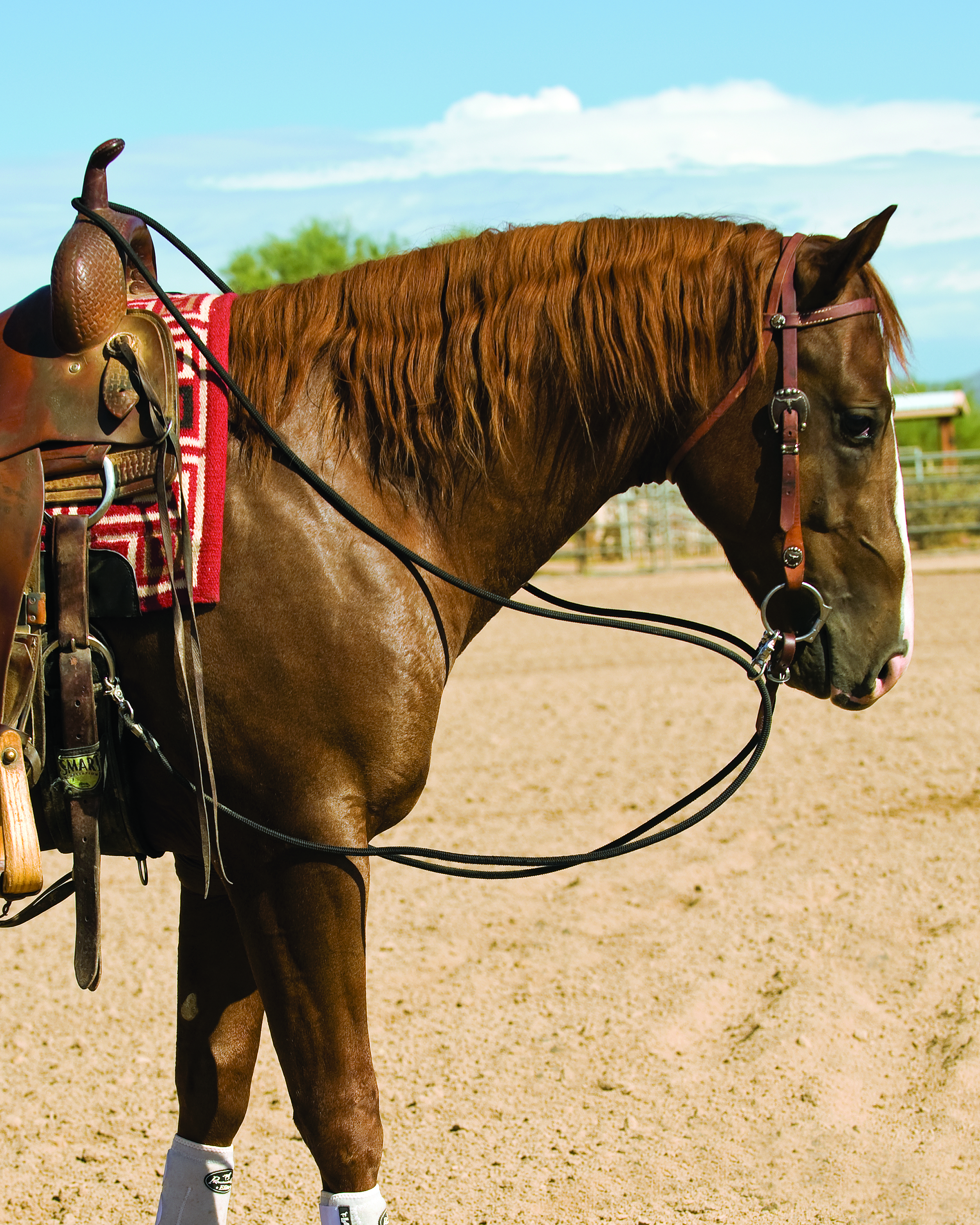
The expert: Bob Avila, all-around horseman and famed reining and working cow horse trainer and member of Team H&R.
Description: This gear consists of a long set of reins of leather or woven cord, or a combination. The reins run down from the rider’s hands through the rings of a snaffle bit, then attach to the cinch between the horse’s front legs or to the rings on both sides of a cinch. They can be used with or in place of normal reins.
How they work: Like a pulley system, draw reins add considerable leverage to the rider’s hands. If the rider’s hands tighten, the reins exert pressure downward, toward the ground, and inward, toward the horse’s chest. Likewise, if the horse raises his head, pressure comes to play on the mouth by the reins affixed to the saddle’s girth or cinch rings.
User comments: “I seldom use draw reins, but the one time I do is when teaching some horses to change leads,” says Avila. Specifically, Avila will use draw reins for a horse that wants to change leads by elevating in front instead of driving from behind. He also sees some utility in using draw reins to “capture” the horse’s head (hold it in a desired position), compress its body, and get its parts to work together, as when teaching a sidepass.
However, the trainer cautions about relying on draw reins for sustained training. “I might use them for a while, but never more than 30 days.”
Gimmick concerns: “Ninety percent of the time, people use draw reins as a crutch,” Avila asserts. “They think draw reins will teach a horse to hold his head down on his own if they just use them long enough. I haven’t seen anyone who was successful at that.”
Steer clear if: You don’t have someone who can teach you how to use them. Like most leverage systems, draw reins add considerable force, but take away feel and feedback. The considerable pressure draw reins exert can injure a horse’s mouth, sore his neck, and serve to make him heavy on his forehand. “Draw reins aren’t a great tool for anyone not experienced in their use and purpose,” Avila concludes.
[READ: Best Western Front Cinches]
Running Martingale
Tack item: Running martingale. Aliases: training fork, training rings.
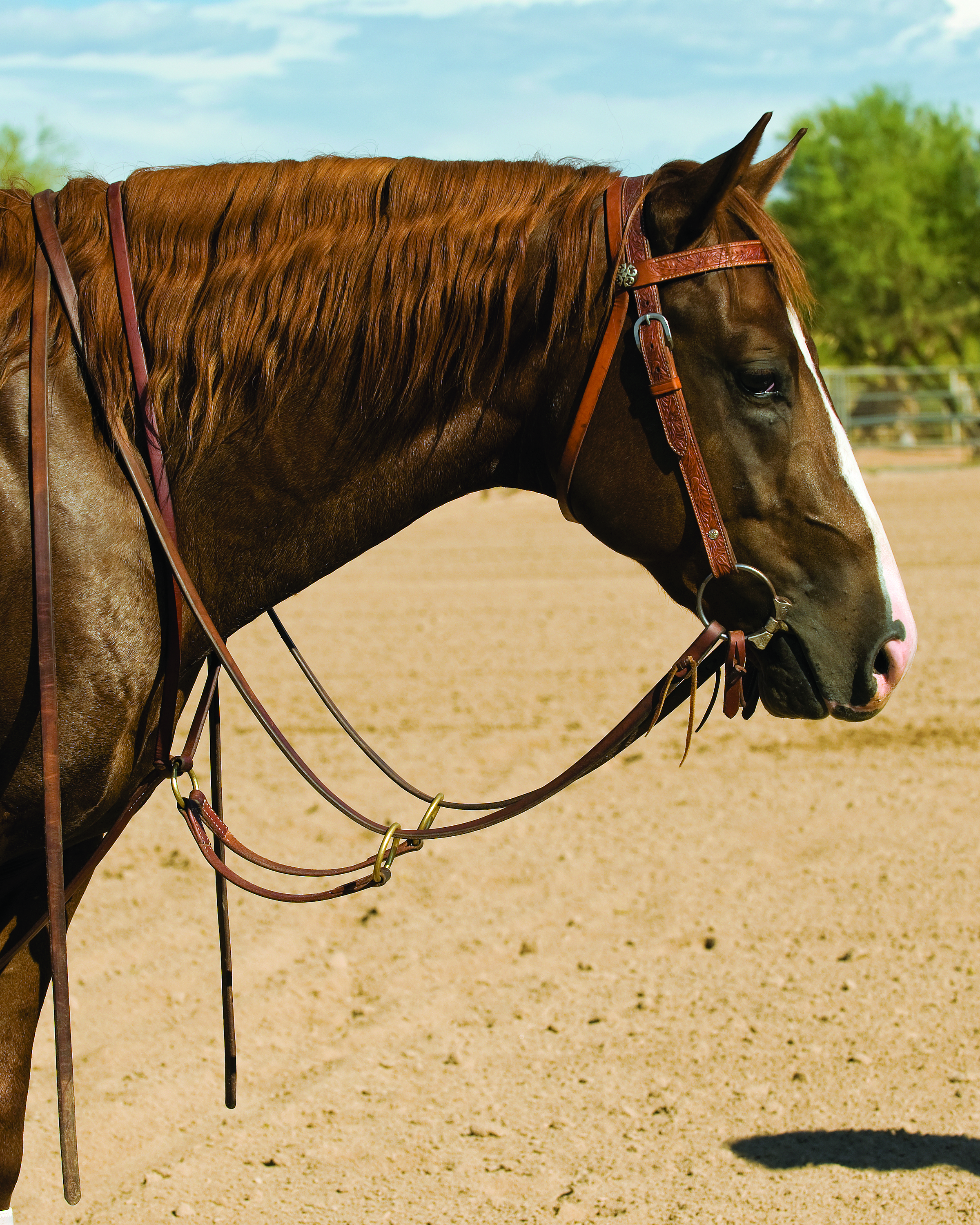
The expert: Julie Goodnight, a popular natural horsemanship clinician, Western trainer, Team H&R member, and host of the RFD-TV show HorseMaster With Julie Goodnight.
Description: The running martingale attaches to the cinch between the horse’s front legs and then forks into two straps with a ring on each end, through which the reins are run. It may or may not have a strap that goes around the neck to hold it up.
How it works: Running martingales are commonly used in Western and English disciplines. Their purpose is to prevent the horse’s head from getting too high. Once the horse’s mouth is above the withers, a rider no longer has control through the reins, so the running martingale is a fail-safe device to prevent the horse’s head from going above the rider’s hands.
User comments: The running martingale is commonly used with young or green horses. If the horse gets excited and his head goes up too high, the device will engage and cause a downward pull on the reins, helping the rider maintain control. Once the horse has gone a period of time without control issues, the rider can cease using the running martingale. However, some riders opt to use it routinely on a high-strung horse that gets too “amped.”
Gimmick concerns: “Many riders misunderstand the purpose of the running martingale, and think it should be used to get the horse to lower his head instead of preventing the head from getting too high,” says Goodnight. “There’s a big difference.”
Adjustment is another factor. When the device is properly adjusted, the rider should be able to lift the martingale’s rings all the way to the horse’s throat; any shorter and the device will pull down on the reins when the horse’s head and the rider’s hands are in a normal position, interfering with communication from the rider’s hands.
Goodnight warns that another common mistake is to use the running martingale without rein stops, which attach to the reins (below the martingale’s rings) and prevent the rings from sliding up too far and getting caught on the bit. “This can cause some crazy wrecks and result in injury to both horse and rider,” she says.
When properly adjusted and used with rein stops, the running martingale is relatively benign, with little potential for abuse. But if it’s adjusted too tightly and pulls down on the reins to lower the head, it becomes a crutch that the rider can’t wean away from—because when it’s taken off, the rein cues feel totally different to the horse.
Steer clear if: Your horse is chronically out of control already and you don’t know how to stop it from happening. “Don’t think the running martingale will solve any problems,” cautions Goodnight. “It doesn’t prevent the horse from getting out of control, but it might help you regain control. You’ll still have to solve the training or physical issue that results in the problem.”
[READ: Selecting a Western Breast-Collar]
German Martingale
Tack Item: German martingale. Alias: cowboy martingale.
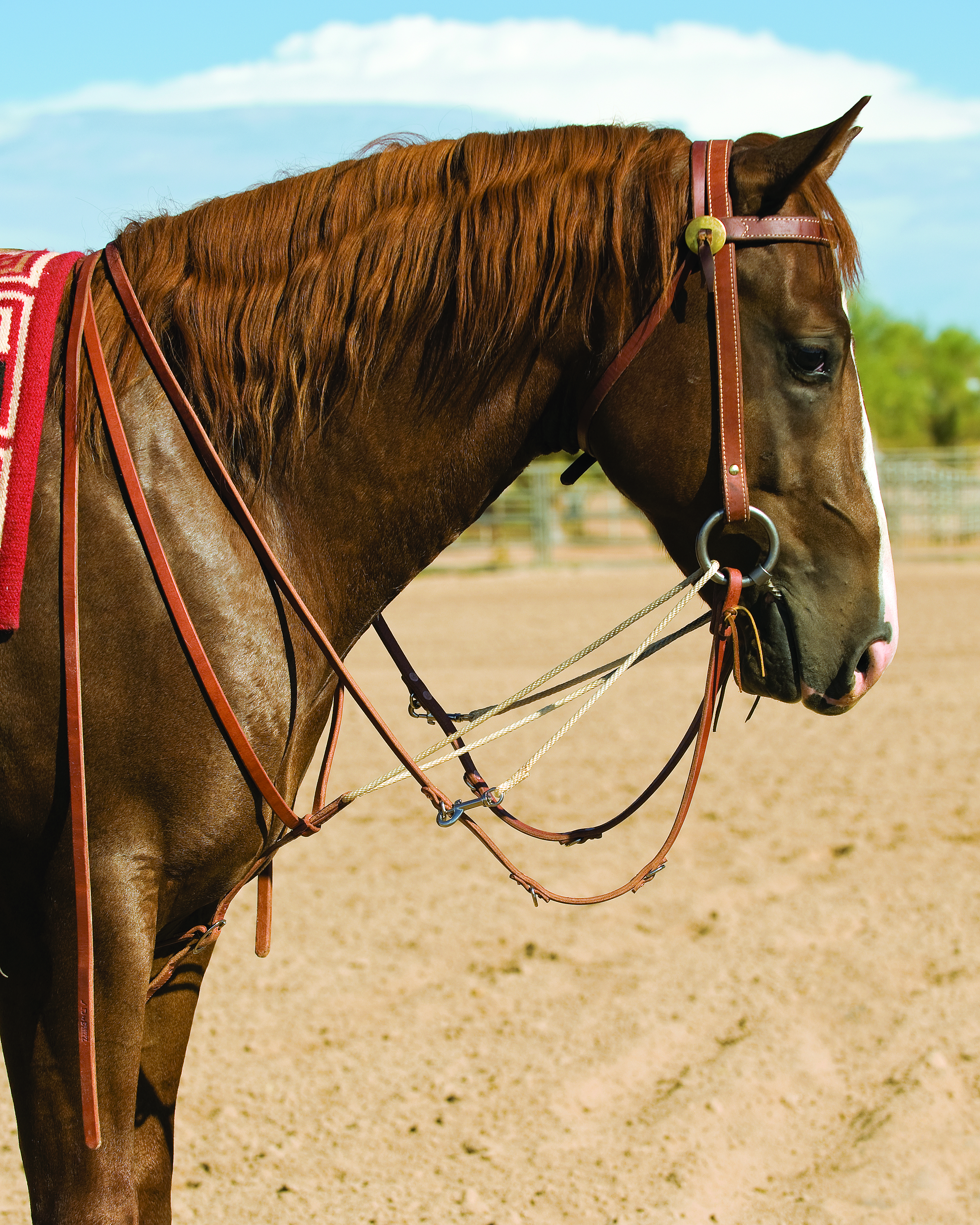
The expert: Al Dunning, Team H&R member whose accomplishments include winning world championships in reining, cutting, working cow horse, and Western riding.
Description: A short piece of rope or leather is attached to the D-ring at the center of the front cinch. This forks to form two pieces, each of which runs through the rings of the snaffle bit and attaches to the regular reins, about 18 inches behind the bit.
How it works: When a horse raises his head, the regular reins go slack but the short leads of the German martingale become taut, exerting pressure on the bit. If the horse yields to the pressure and lowers his head, the German martingale goes slack and response is restored to the reins themselves.
User comments: “I’m an advocate of it,” says Dunning. “If there’s one piece of specialty equipment I would recommend, this is it. I’ve even designed my own Al Dunning German Martingale.”
Dunning goes on to explain that if the horse raises his head out of position, losing poll flexion and tipping his nose upward, the German martingale exerts pressure and reminds the horse to tip his nose and lower his head. If the horse pushes against the rider’s hands, the device engages to help bring his head back to a soft, vertical position. Then, it releases and allows the rider to ride with hands on the straight rein, with nothing pulling on the bit.
Gimmick concerns: To be effective, the German martingale must be adjusted to release when the horse’s head becomes vertical. Even when properly fitted, the device can act quickly and suddenly, causing unpredictable reactions in a horse that’s not accustomed to it. Also, this gear won’t compensate for a rider who doesn’t know how to get proper drive and collection in the hind end.
“All these (tie-down) devices are no good unless you use your legs and ride the back of the horse to the front,” says Dunning. “All of them give resistance in front, so you can drive the back end and get the horse to round up.”
Steer clear if: Your horse has a tendency to rear. As a German martingale engages on a rearing horse, it can cause him to lose his balance and fall over.
[READ: Gimmick Free Bits]
Tie-Down
Tack item: Tie-down.
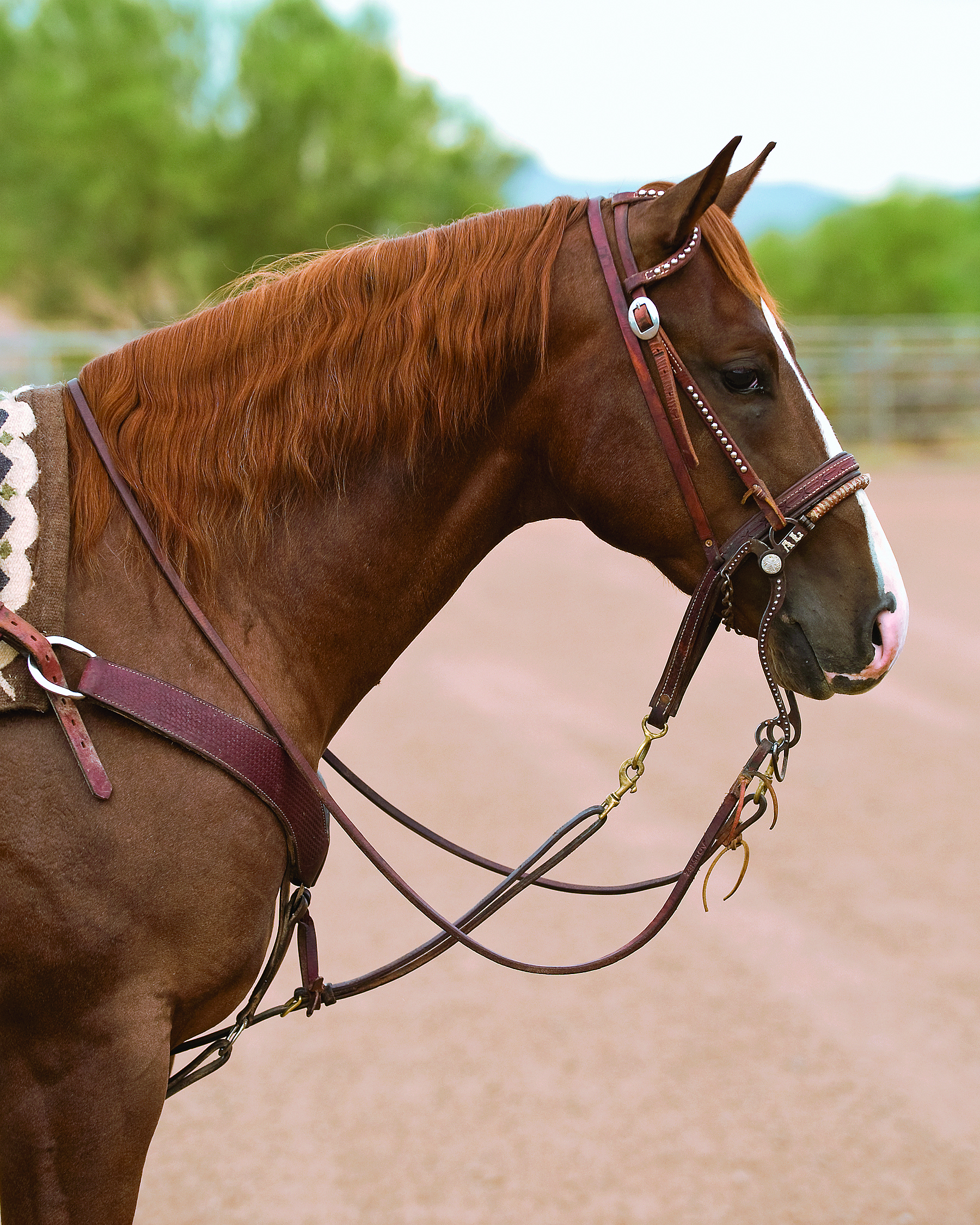
The expert: Fred Whitfield, seven-time Pro Rodeo Cowboys Association World Champion Calf Roper and 1999 PRCA All-Around Champion.
Description: A leather, rope, or nylon strap is attached to the D-ring of the cinch, run up through the breast collar, and linked to a noseband that’s supported by a hanger that loops over the horse’s poll. Nosebands can be soft, as with a wide strap of smooth saddle leather, or hard, using a narrower material such as nylon strap or a piece of braided rope or cable, the latter typically covered with a sheath of rubber or plastic.
How it works: A tie-down is a simple device. If the horse raises his head, the tie-down exerts force on the nose; it can also be designed to exert pressure on the poll through the bridle-like hanger.
User comments: “A tie-down keeps the horse’s head down and out of the way and gives him something to brace against when he stops,” says Whitfield. “I use several different kinds, either soft or hard, depending on the horse.” The roper also says that when the horse lifts his head in the stop and feels the tension of the tie-down, his first reaction is to back, which is desirable. But, he adds, “If the (roping) horse is exceptional, you might not need the tie-down.”
Gimmick concerns: Roping is a fast event, and as soon as a run is over, the rider can release pressure by unsnapping the tie-down. But for everyday riding, the continuous use of a tie-down puts strain on the neck muscles and vertebrae, possibly leading to arthritis over the long term.
Outside the arena, a horse encounters uneven ground, obstacles, and more that can upset his balance. Because a horse uses his neck for balance, a tie-down can prevent him from regaining lost balance and thus cause wrecks. Horses crossing streams with tie-downs have drowned. Further, tie-downs can be crutches that compensate for inadequate training, heavy hands, or fear on the part of the rider.
“It might be a cliché, but I always tell people, ‘You have to be smarter than your horse,’” advises Whitfield. “Whether to use a tie-down, and what kind you use, has a lot to do with the horse you’re riding.”
Steer clear if: Your horse has an undiagnosed reason for tossing his head. For instance, if he has dental problems or a pinching bit, using a tie-down won’t solve the underlying issues.
[READ: Tips to Stretch Your Tack Budget]
Sidepull
Tack item: Sidepull. Aliases: Bitless bridle, Bozo bridle, Indian hackamore, and a number of others named for their inventors.
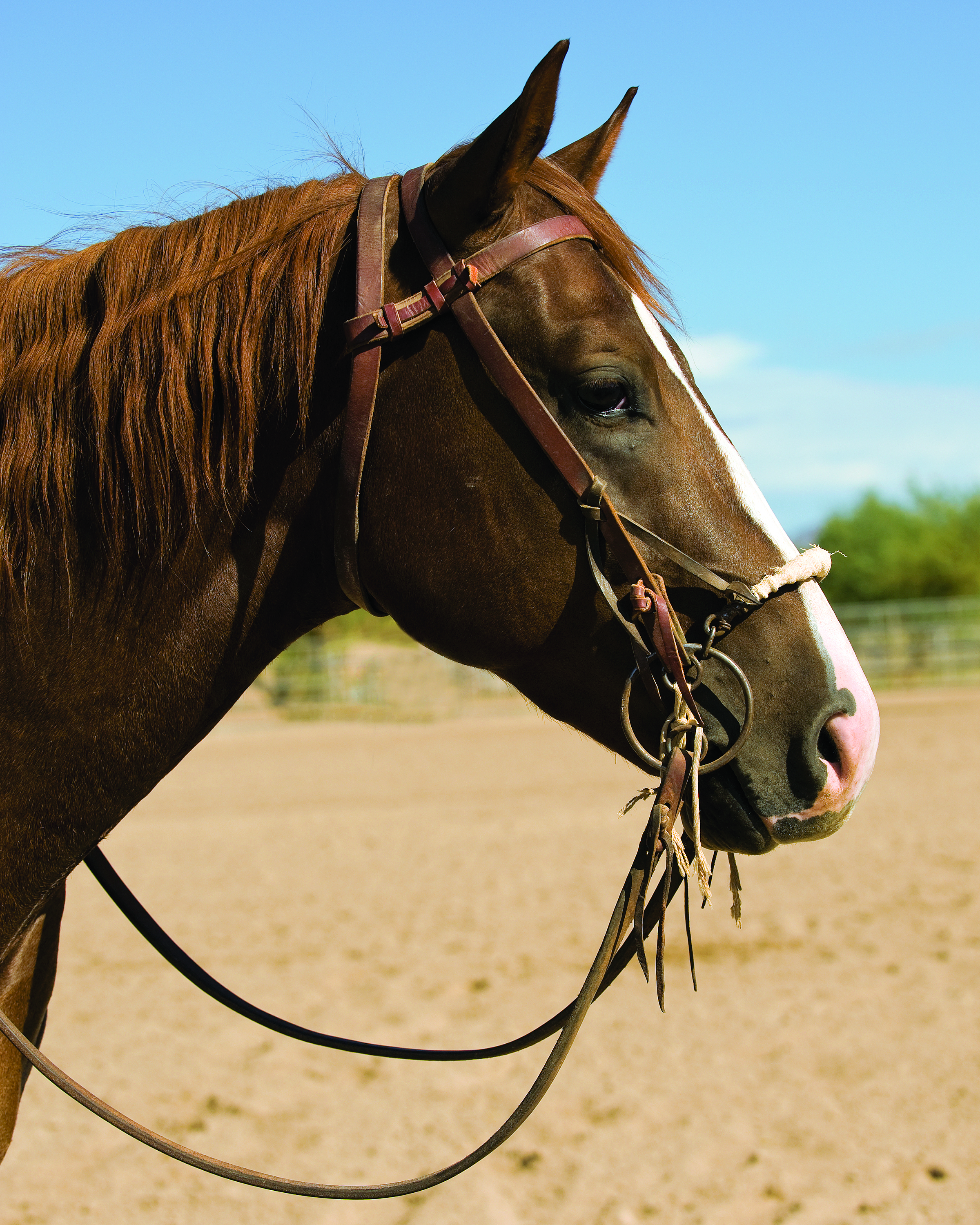
The expert: Kristie Peterson, four-time Women’s Professional Rodeo Association World Champion Barrel Racer.
Description: A number of designs are categorized as sidepulls and bitless bridles, but two main designs predominate.
The first is a leather or nylon headstall, almost like a halter. The reins attach near the cheek, cross below the horse’s jaw, and then run through steel rings located just below the noseband. It’s the gentler of the two designs.
Peterson’s Bozo Sidepull Bridle by Classic Equine® is a replica of the headgear used by Peterson on her horse, French Flash Hawk (Bozo), who carried her to four world titles. These are akin to “soft” mechanical hackamores, with steel shanks, a noseband, and curb chain under the jaw.
How it works: Rather than applying pressure to the mouth, sidepulls exert pressure either on the nose and chin, or the nose, chin, and poll. Reining is mostly direct: If the rider pulls on one rein, it directs the horse’s head to that side. When the rider pulls on both reins, pressure is exerted down and back to “check” the horse or signal a stop.
User comments: Early in Bozo’s career, Peterson ran mainly in futurity events using an O-ring snaffle bit. “Bozo never liked the snaffle—he always gagged,” she says. “After he got to be 5 years old, my friend Steve Lazor made a sidepull. I tried it on Bozo, and he never used anything else his entire career.”
Peterson now recommends a sidepull when a horse is bit-sensitive, prone to throwing or shaking his head, roots at a bit, or has suffered dental or tongue damage. It’s also a solution for riders who are too active with their hands or, as she says, “always ride with their hands in the horse’s mouth.” A horse that’s been desensitized to bit control could also respond to a changeover to a sidepull design.
The champion barrel racer also recommends her design for barrel horses that tend to laterally overbend, and even for trail riding. “I find with many horses, it relaxes them,” she says.
Gimmick concerns: Although bridleless designs are fashionable among individuals looking for humane gear, some side pulls can in fact be harsh. Placed high up on the horse’s face, they can put pressure on sensitive facial nerves. They can also exert vise-like force on the nose and mandible, especially the hackamore-like designs with shanks that increase leverage.
Creators of certain designs claim them to be pain-free, making the point that the bitless-bridle design exerts pressure across a broad area, including the poll, nose, and jaw—as though the rider is cradling the horse’s head. Weigh such claims against your horse’s degree of training.
Steer clear if: A bit already works for your horse. “This isn’t a training device,” Peterson notes of her Bozo sidepull. “It’s for a finished horse.” Also, any of these designs might not be permissible in the arena by competitive associations. Be sure to check rules before committing to a program that employs one of the sidepull or bitless-bridle designs.
Mechanical Hackamore
Tack item: Mechanical hackamore. Aliases: Mechanical bridle, Kelly hackamore.
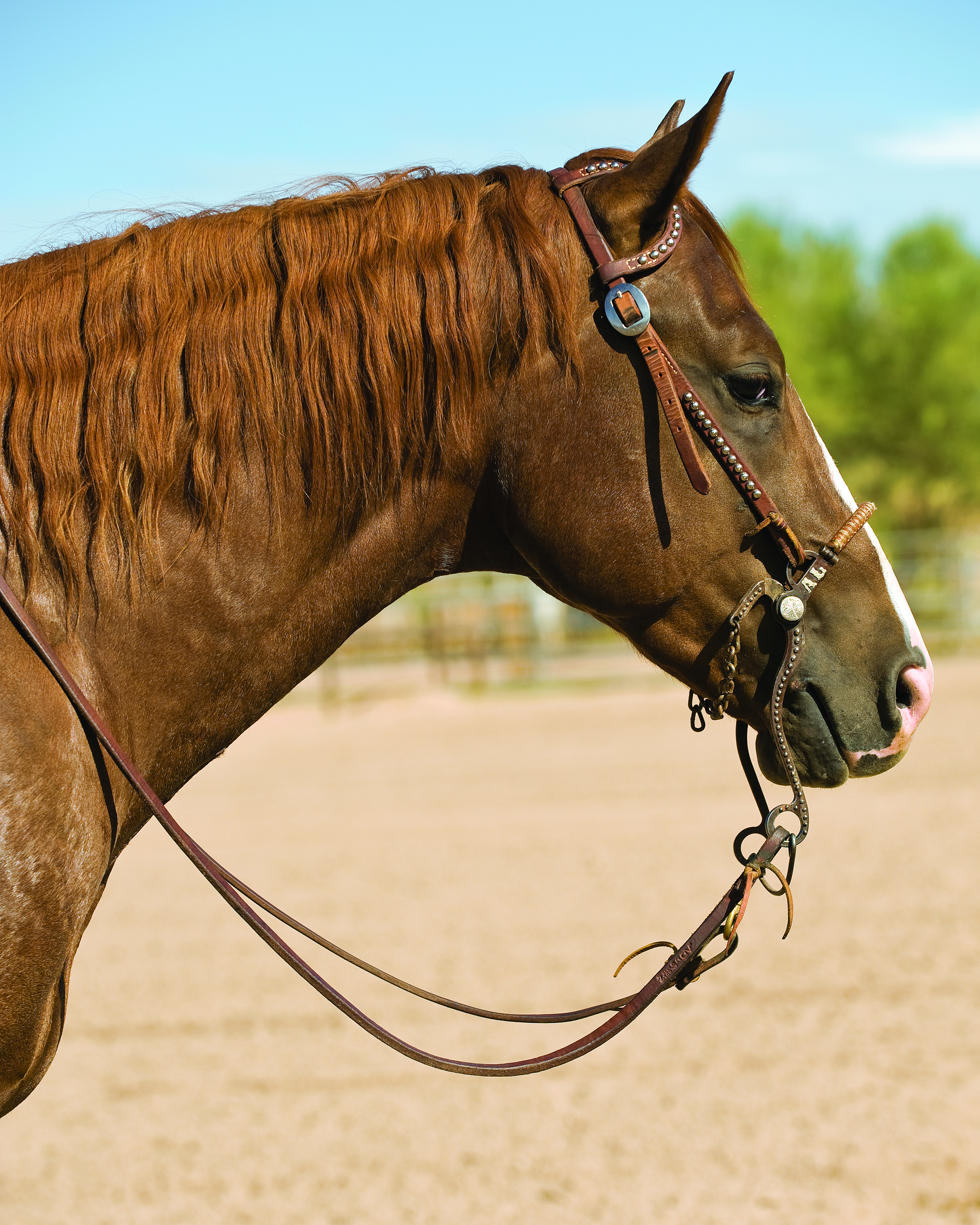
The expert: Clinton Anderson, famed clinician, Team H&R member, and star of the Fox Sports Net show Downunder Horsemanship.
Description: A mechanical hackamore operates as a bitless-bridle design based on the classic bosal, in that it applies pressure to the bridge of a horse’s nose and beneath his lower jaw. But unlike the noseband of a bosal, the noseband of a mechanical hackamore attaches to two steel shanks, to which is attached a curb chain that runs under the horse’s chin.
How its works: When a rider draws the reins, he or she engages the shanks, which in turn tighten the curb chain. This exerts force on the noseband, capturing the horse’s nose and lower jaw with a vise-like action. Reining tends to be direct, as pulling on a single rein will pull the horse’s face in that direction (although this isn’t necessary if a horse is trained to neck rein).
User comments: Like many other trainers, Anderson sees little utility in this design because it’s seldom permitted for arena use.
“I don’t like it,” he states flatly. “It tends to lift the head, and it can also cause the horse to throw his head. And it can’t be used for most show competitions. I find it best not to use equipment you can’t show in.”
That said, Anderson admits that some riders might find the mechanical hackamore useful. “Any piece of equipment can work with the right rider, with a rider who has light and sensitive hands. But with the wrong rider, the mechanical hackamore exerts a lot of pressure on the nose. There’s just a lot of pressure that comes from those long shanks.”
Gimmick concerns: This is a piece of gear that has its place. For the recreational trail rider whose horse is trustworthy without constant rein pressure, the mechanical hackamore can be useful in that it readily allows grazing yet affords control when necessary. Similarly, it can solve problems for the rider whose horse has become desensitized to the bit or has facial or cranial issues.
However, one needs to be sensitive to the fact that, even though it might appear more forgiving than a bit, the mechanical hackamore creates a great deal of leverage and can be abusive in hard hands.
Steer clear if: You don’t have a specialized need, as outlined above; your aim is to compete in the show arena; or your horse is already working well in a traditional bit. An alternative, such as a sidepull or a traditional bosal, might be a better solution for many riders than a mechanical hackamore.
Twisted-Wire Snaffle
Tack item: Twisted-wire snaffle.
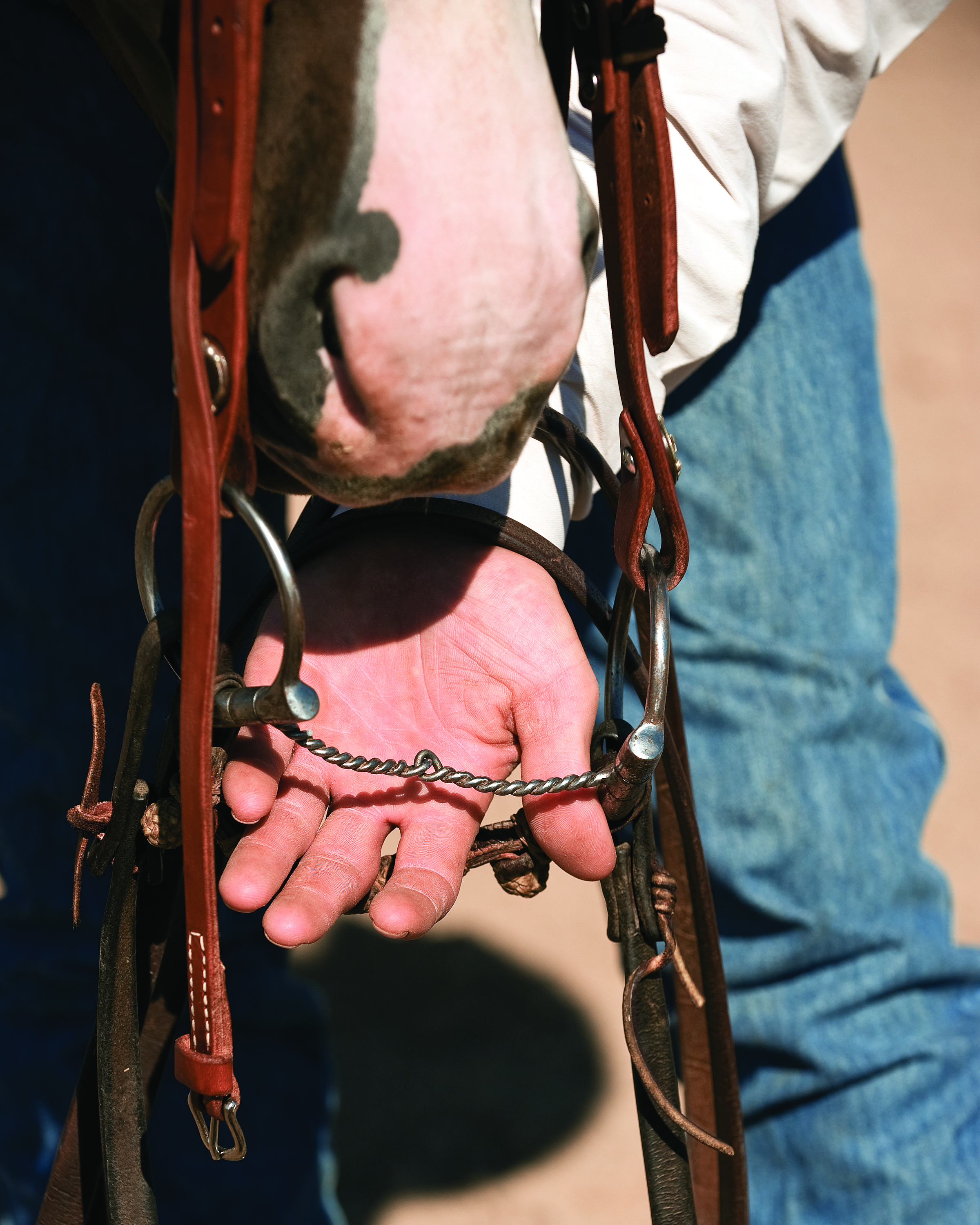
The expert: Gordon Potts, Team H&R member and owner/founder of The Brass Ring, a full-service show-horse, training, and breeding facility that’s produced Arabian national champions in English and Western events.
Description: The twisted-wire snaffle is made of two O-rings bridged by pieces of twisted wire joined in the middle. Use requires care and skill.
How it works: The non-smooth surface of the mouthpiece sensitizes the horse’s mouth to bit pressure. Many trainers advocate a progression of bits, in which the horse is started with a smooth, large-surface snaffle, then moves to smaller-surface and more sensitizing snaffles as he gains experience and possibly becomes less responsive to the earlier bits. In theory, the horse should maintain responsiveness and lightness throughout the progression.
However, if a horse should become less responsive, a trainer might employ a twisted-wire snaffle for short periods to lighten up a horse’s mouth.
User comments: “When a horse is getting dull on a smooth snaffle, the twisted-wire snaffle gives you a place to go,” says Potts. “When used correctly, it’s a useful tool for advancing a horse’s training.”
Gimmick concerns: A twisted-wire snaffle can damage a horse’s mouth if not used with supreme care and skill. It should never be employed by an unschooled or heavy-handed rider, whose lack of feel and timing could be the very cause of the horse’s dullness to a milder bit. “In the wrong hands, this bit can cut into a horse’s mouth, which can lead to head tossing and getting ‘above the bridle,’” cautions Potts.
Steer clear if: You’re not a light-handed rider with a well-advanced degree of feel, and/or you’re a rider who can’t control his or her temper and digresses to jerking on the reins when a horse isn’t performing as desired.
[READ: Online Tack Bargains]






